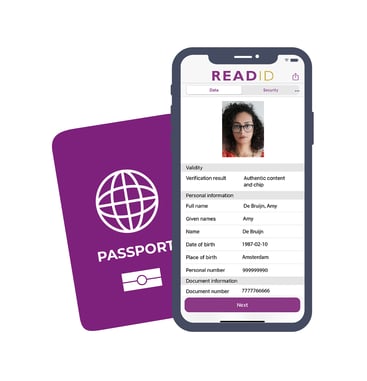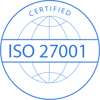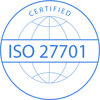Earlier this year a pilot was conducted between the Netherlands and Canada to test if and how Digital Travel Credentials (DTC) can help to make border management processes more effective and efficient. On 1 July 2024 the evaluation report was sent to the Dutch parliament. The overall conclusion of the pilot was positive, proving that DTC can be applied in border control processes. There were, however, some issues in the pilot that limited the success. For clarity, Inverid was not part of the pilot.
An important component of the pilot was an app to read the NFC chips of passports to create a DTC. The conversion for this step was poor. The conclusions of the evaluation report suggest this is because the technology is not mature enough. We strongly believe this conclusion in unfounded: our own research and customer feedback proves that high conversion can be realised even with a much higher diversity in documents than in the pilot. Inverid’s ReadID, launched 2014, is a similar app and is used in large-scale production use cases. These cases have proven this technology to be very successful with a high conversion rate. Conversion varies on things like motivation of the user and UX, but we’ve shown it should always be above 90% for first try, or you’re doing something wrong, and it should be above 95% if you do the UX and tech right.
Conversion in production should be above 90% for first try, and above 95% if you do the UX and tech right.
Since this conclusion in now in a formal evaluation report and was also presented in public at EIC 2024 and Identity Week EU 2024, we decided to write this blog to present our view on this in our view incorrect conclusion, explaining how other DTC pilots can be way more successful.
The context and setup of the pilot
The pilot was requested by the European Commission, and executed by a public-private cooperation of the Dutch Government (Min JenV, Min BZK, KMar, RvIG), KLM, Schiphol and Idemia as supplier. It ran only between Schiphol and Montreal-Trudeau, for Dutch, Belgian and Canadian travellers.
The basic idea is that travellers use an app to read the NFC chip of their passports, creating a so-called Digital Travel Credential – Virtual Component (DTC-VC, specifically a DTC type 1), which is basically a virtual version of a passport chip. This DTC is then shared before travelling, and a new type of Tap & Go e-gate uses this DTC-VC plus a facial scan to speed up passing through this gate. In the pilot the travelers thus still need to present their passport to the gate, but there is only a short interaction rather than a full read.

The DTC1 pilot process (source: evaluation report).
The pilot has been explained in a video. In this blog post we focus on the reading of the passport chip with the app. There are many learnings from this process and from the pilot, and much of it is very valuable. Please read the full evaluation report for more background.
Effective app-based passport verification
Over the last few years, ReadID has been used in two other well-known apps for more efficient border management processes: Eurostar, in production since July 2023 following pilots in 2021, with our partners iProov and Entrust, and the recent Frontex Entry and Exit System pilot in Sweden. The latter finished end of June 2024, a week before the writing of this blog post. Specifics on the outcome will follow over the summer from Frontex, but as a spoiler alert: the NFC reading worked well.
The Dutch DTC pilot had a negative outcome concerning NFC. Since we like data: out of 2713 attempted passport chip readings, 1348 failed. This is roughly half of all readings, a very poor conversion rate that we do not recognise in any production use case of ReadID. Pilots can have a higher or lower conversion rate than production services, depending a lot on the pilot, but even then 50% conversion to read the NFC chip is simply not explainable to us as anything but a poor implementation and/or UX. Other native outcomes related to the NFC read were that on average users needed 2.5 attempts to read the chip, and that Active Authentication (cloning detection) failed on 73 out of 751 Canadian passports.
If we compare this to some publicly available conversion numbers for NFC:
-
The UK Home Office used ReadID and NFC under the so-called EU Settlement Scheme. A survey after more than 3 million applications showed that 79% of users found the app easy to use (86% easy or neutral).
-
Moneyou, a Dutch mortgage provider, subsidiary of ABN Amro, reached over 95% conversion in their application, including face verification.
This problem with reading the NFC chip in the pilot fuelled a number of conclusions in the pilot evaluation that we strongly disagree with. The first such conclusion: “Another learning to be shared is that there is not enough industry standardisation to ensure successful DTC-creation for an app on all phones.” Although it is true that not all phones have NFC, it will be difficult to find a significant number of phones in the countries involved that do not support NFC. This might have been a fair statement before Apple opened up their NFC, but this already happened in September 2019. Basically all Android and iOS phones since the iPhone 7 support NFC and therefore efficient passport reading.
A second conclusion was that it that does not make sense to us to not use Chip Authentication (one of two possible ways to do cloning detection). The report states: “Chip Authentication (CA) needs to be implemented. Pilot limitation allowed only for Active Authentication (AA). CA and AA are interchangeable ways to check whether the chip is cloned. CA additionally adds encryption of the chip and passport readers communication. Therefore, this protocol is preferred, when available. To enable this, it requires new EU-regulation.” The report does not refer to a specific regulation, but to the best of our knowledge there is no such regulation. Possibly there was a confusion with Terminal Authentication (which would allow access to fingerprints), but this is a hypothesis on our side.
A third statement we do not agree with is “The statistics show that a happy flow without any retries hardly ever happens. Almost every pilot participant has to perform either reading the passport chip or selfie image verification multiple times. The passport chip reading element is hard to change as this is caused by technology that is often not mature enough. It is necessary to align the NFC reader in the phone correctly with the chip and its antenna. However, the position of these components vary per phone and passport model. So the traveller cannot be handed specific instructions on the relative positioning of passport and phone.” The challenge the report describes is very true, i.e., the user has to position the antenna of the passport with the antenna of the phone, and the positions vary greatly based on model of phone and type of identity document. But this is why ReadID has a database with these locations for both phones and passports, and provides custom animations to guide the user to the right spot for NFC reading. When we introduced these dynamic customer animations in ReadID in 2020, our conversion went up by 20% on some phone models.
Great NFC reading is a challenge, but that challenge has been solved
The conclusion chapter summarises the evaluation of NFC in the following statement: “In the pilot it was difficult to create an app that worked well on various types of phones and with a limited number of passports. Given the current state of technology, it might remain challenging to create an app that derives DTCs from all passports on all types of phones.” We concur that it is a challenge, but our conclusion is completely the opposite. We learned this is hard ourselves when we started with NFC-based document verification about 10 years ago, but this challenge has been solved in practice, for nearly all phones and documents from more than 170 countries. We shield app developers from this difficulty through our ReadID SDK with its best-practice UX and phone/passport specific optimisations. We’ve been using this since 2014 is very large use case, with millions of first-time self-service users with a large diversity in phones and passports. Passport positioning is just one of several UX challenges we solved to get to optimal conversion.
The pilot showed that implementing NFC is not easy, but the conclusion should be to improve the implementation, not that it is not possible.
Bottom-line: the purpose of a pilot is to learn, and the Dutch DTC pilot involved more than just NFC. It resulted in an overall positive conclusion on the potential of DTC. With respect to NFC, the pilot showed that implementing NFC is not easy, but the conclusion should be to improve the implementation, not that it is not possible.










